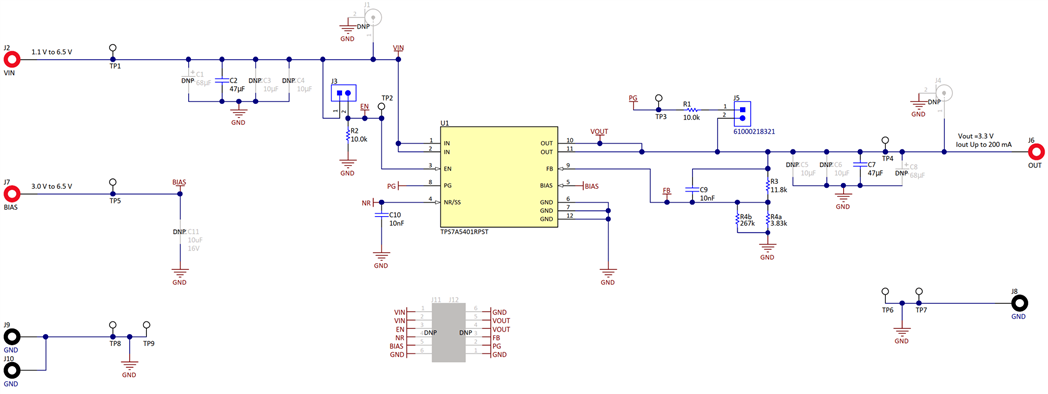I am testing the achievable accuracy of this regulator for powering sensitive parallel optical transceivers. The regulator datasheet states multiple accuracies
- Page 5: 0.75% for VIN between 1.4 V and 6.5 V
- Page 5: 0.5% for VIN = 1.1 V with VBIAS between 3 V and 6.5 V
- Page 16: "This device achieves a maximum of 1% output voltage accuracy
I am using the TPS7A54EVM-031 with Vin = 5 V aiming to get Vout = 3.3 V. For the feedback voltage divider, I have replaced R3 and R4 with the same size resistors with 0.1% tolerance as the following:
- R3 = 11.8 kΩ
- R4 = 3.776 kΩ (which is made of two resistors 3.83||2670)
Using different output accuracy calculation methods including the suggested method in this document by TI I find that output voltage should be:
- 3.279 V to 3.322 V for regulator accuracy of 0.5%
- 3.270 V to 3.330 V for regulator accuracy of 0.75%
However, conducting multiple measurements with a load current of 0A or 300mA using different instruments, including SDA816Zi-A oscilloscope with PP007-WR and DAQ6510 multimeter, to measure at points close to the IC showed that Vout = 3.330 V.
Can you please help me answer the below questions:
- What is the 1% accuracy mentioned on page 16? Is that the actual achievable accuracy? If so, then the measure Vout = 3.330 V is within regulator specifications
- The accuracy of 0.5% stated on page 5 requires powering the bias pin and works for low Vin and Vout. Does that mean that there is no way to achieve it for Vin =5 V and Vout = 3.3 V without powering the bias pin? Is there a recommended voltage to power the bias pin to get this accuracy for Vin = 5 V and Vout = 3.3 V?
- The measured Vout = 3.330 V is sitting right at the upper edge of the achievable Vout for regulator accuracy of 0.75% using the current configuration. should I then accept that the the achievable accuracy will be 0.75% and can't guarantee it to become 0.5%?
Kind regards
Nick



